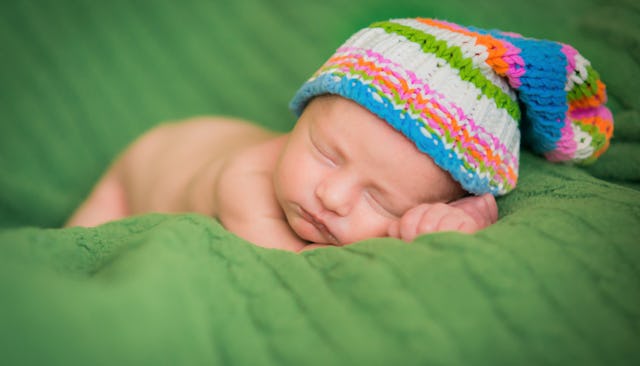What I've Learned About Babies And Sleep

My introduction to the mysterious world of children and sleep was my 3-year-old stepson who used to cock-a-doodle-doo at sunrise, which seemed ungodly to me. I was certain I could teach my own children to be different—more reasonable.
My first daughter was yanked, face up into the world a year later. Skin-on-skin was with Dad because I was wheeled off for stitches and damage control.
That night I tried to feed her, I changed her, and I swaddled her and put her down into the transparent plastic cot beside my hospital bed—a recommended, safe distance for sleeping. My daughter cried. I wanted to do it right. I tried to feed her again and checked if she needed changing. I swaddled her and put her down into the plastic cot beside my hospital bed—a safe distance from me for sleeping. My daughter continued to cry.
A midwife on the ward came in, put me into bed and tucked my daughter in the crook of my arm next to me. My daughter slept.
I was terrified. I thought, “This isn’t how I want it to be.”
I didn’t want to co-sleep. We swaddled, and we used a pacifier. At the recommended age, I took the pacifier off her. At 5 months, she went on a nap strike. When she got older, I let her cry. I was determined to create a good sleeper. I was too focused on the outcomes to consider whether or not I was happy with the kind of mother I was in the moment. Being woken up at 5:45 a.m. by crying for almost two years saved me heaps on radio alarm clocks.
Now I’ve learned: Sometime babies just fuss to be near their mother. That’s what babies do.
My second daughter arrived quietly in a euphoria of an epidural and laughing gas. The fiery-looking redhead was as placid as Gandhi. During skin-to-skin, I welcomed her to the family and apologized for the violence in the world, promising she was in good hands.
Two hours after her birth, she was a sleeping bundle of blankets in the cot next to my hospital bed. At 3 months, she slept 7 p.m. to 7 a.m. And at 20 months still enjoys a two-hour afternoon nap, diving under the covers, thumb in mouth. Had I finally cracked this motherhood sleep thing?
Now I’ve learned: Some babies are sleepy babies. Some babies are not.
My third daughter emerged with one fist clenched above her head like a warrior. Clamping on to my nipple, I knew we had another tongue-tied baby. A windy little giantess with a short tongue who took in a lot of air during feeds and subsequently screamed at random in her sleep.
I’ve learned: Some babies need to suck. That’s just what some babies need to do.
The stargazer. The pacifist. The amazon.
Three girls have taught me that babies are people too. Individuals with their own preferences and weaknesses. We do not get to choose who our babies are—not their hair color, eye color, temperament or circadian rhythms.
I’ve learned: Sleep is like water.
Sleep can be steered but never controlled. I have regrets about how I parented before I understood this, mostly about how hard I was on myself, for ignoring my gut about what kind of parenting I was most comfortable with. We do not determine their outcomes. We only chose what kind of parent we are in the moment, not the end result.
I’ve learned: Parenting is not controlling. Parenting is not creating. Parenting is responding.
While we might use science to influence our decisions, parenting is not a science. Parenting is an art, if we’re doing it right. However, I’m pretty sure I’m not.
I’ve learned that I’m still learning. I can sleep later.
This article was originally published on